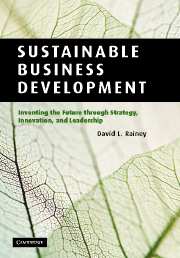Book contents
- Frontmatter
- Contents
- List of figures
- List of tables
- List of boxes
- List of abbreviations
- Acknowledgments
- Introduction
- Part I Enterprise thinking, the driving forces of change, and leadership
- Part II Innovation management, life cycle considerations, and insights
- 7 Sustainable technology management and development
- 8 Crafting and implementing sustainable business development programs
- 9 Life cycle thinking and framework
- 10 Formulation of life cycle assessment: initiation and inventory assessment
- 11 Implementation of life cycle assessment: impact and improvement assessments
- 12 Inventing the future through enterprise thinking and sustainable business development
- Glossary
- Select bibliography
- Index
- References
8 - Crafting and implementing sustainable business development programs
from Part II - Innovation management, life cycle considerations, and insights
Published online by Cambridge University Press: 04 December 2009
- Frontmatter
- Contents
- List of figures
- List of tables
- List of boxes
- List of abbreviations
- Acknowledgments
- Introduction
- Part I Enterprise thinking, the driving forces of change, and leadership
- Part II Innovation management, life cycle considerations, and insights
- 7 Sustainable technology management and development
- 8 Crafting and implementing sustainable business development programs
- 9 Life cycle thinking and framework
- 10 Formulation of life cycle assessment: initiation and inventory assessment
- 11 Implementation of life cycle assessment: impact and improvement assessments
- 12 Inventing the future through enterprise thinking and sustainable business development
- Glossary
- Select bibliography
- Index
- References
Summary
Introduction
This chapter explores product and technology development and related programs and processes, as they may be used to support SBD. It examines program types, planning models, and selected development processes, including the identification, selection, planning, implementation, and integration of development programs for sustaining the vision and strategic direction of the enterprise. The constructs discussed are based on enterprise thinking and SBD. Their aim is to create innovative solutions that involve significant improvements to the strategic position of the enterprise and the value propositions for its constituents.
The selection of effective development programs depends on the capabilities, skills, knowledge, desires, and resources of the corporation. The selection may be determined by the requirements, mandates, and standards of the business environment and by the strengths and weaknesses of the existing technologies, products, and processes. The underlying social, economic, and environmental considerations and the identifiable needs and wants of customers and stakeholders also play significant roles. Selecting programs uses methods, processes, and analytical techniques that link technological innovation, product development, and process improvement to the objectives and strategies of the enterprise.
The basic philosophy for building a sustainable enterprise is to invest in development programs that create value streams that exceed social, economic, environmental, technological, and financial requirements and expectations. Value streams and outcomes must focus on delighting customers and stakeholders and building a foundation that provides great solutions for all constituents. The intent is to do so while decreasing resource requirements, defects, and burdens, and negative impacts on the business environment.
Information
- Type
- Chapter
- Information
- Sustainable Business DevelopmentInventing the Future Through Strategy, Innovation, and Leadership, pp. 444 - 506Publisher: Cambridge University PressPrint publication year: 2006
